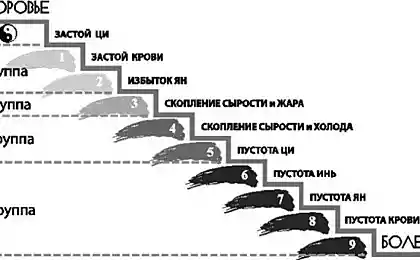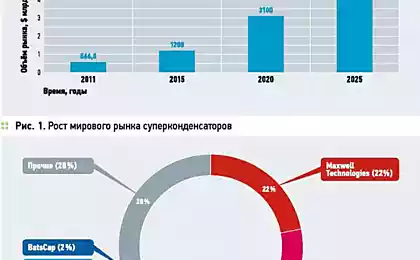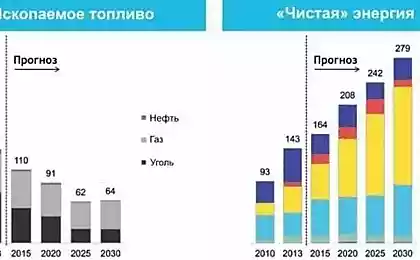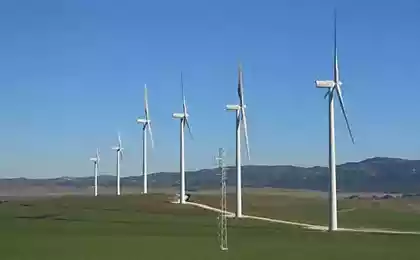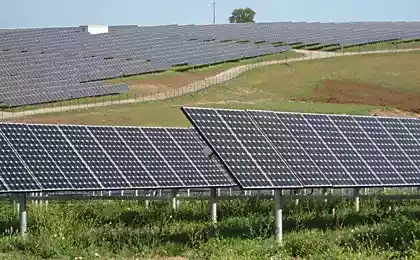1442
Interesting facts about energy

Only 10% of the energy used by an electric lamp for lighting. The rest of the energy goes into heat. On the other hand, the compact fluorescent bulbs used 80% less energy and last 12 times longer.
Refrigerators in the US consume about the same amount of energy that is produced 25 large power plants.
The energy of sunlight is enough to provide all the needs of humanity.
There are two basic types of energy: renewable energy (biomass, geothermal, solar, wind and water) and non-renewable (energy derived from fossil coal, oil and gas, and nuclear power). Three-quarters of the world's energy consumption produced from the burning of fossil fuels.
It is expected that from 2008 to 2030, global energy consumption will increase by more than 55%.
5000 years ago the average person to survive required to consume 12,000 calories a day, in the early 15th century, it became necessary to 26,000 calories a day. After the Industrial Revolution in the third quarter of the XIX century, the average consumer of energy used 77 000 kcal. By 1975, energy consumption has tripled and the man reached 230 000 kcal per day.
Google data center used 260 million megawatts of power in 2010. Google uses about 0.013% of global energy consumption. It would be enough for a constant supply of about 200tysyach dwellings.
Half the energy produced in the United States by burning coal. China uses coal to generate three-quarters of the necessary energy. More quantity of coal as a percentage used in Australia, South Africa and Poland. In general, coal generated 2/5 of all electricity produced on our planet.
10 country produces 2/3 of the world's oil and have the same ratio of proven reserves. A list of these countries led by Saudi Arabia.
10 country produces 2/3 of the world's natural gas and have the same ratio of its reserves.
Nuclear power plants the United States produces more electricity than any other country - about 1/3 of world production. The second largest producer of this energy is France, which generates electrical energy ¾ of its nuclear reactors.
The most powerful hydroelectric complex in the world are Chinese Three Great Dam. Contradictory in its significance giant station supplies electricity to millions of Chinese peasants and generates more than 22,000 megawatts by means of 6 turbines.
In 2007, wind power produced 1, 3% of the world's electricity. The world's largest wind farm - a wind energy center in Abilene, Texas. Occupying the territory of 238 square kilometers, the center has 400 turbines located on poles 80 feet high. They produce a total of 735 megawatts of electricity.
About 30% of which are supplied with all types of buildings, using either inefficient or unnecessarily.
The cost of heating and cooling accounts for about half the total bill for the payment of electricity in the United States.
On average, one pump to pump water into the pool consumes 44% of the electricity used in a typical private home ownership in California. In America - about 7 million pools.
In the last 50 years, the amount of carbon dioxide in the atmosphere has increased to an unprecedented magnitude over the past 400,000 years. The main release of CO2 gas into the atmosphere from burning fossil fuels.
US hospitals are among the most energy-intensive buildings on the planet.
James Hansen, director of NASA (Institute for Space Research) said that coal is one of the biggest threats to civilization and all life on the planet. In America-burning coal emits more gas CO2, than all the cars with internal combustion engines, taken together.
On a hot summer afternoon California absorbs energy equal to the full impact of two large nuclear reactors for pumping water in swimming pools.
China overtook SSCHA as the world's largest consumer of energy and the country is released into the atmosphere the greatest amount of gas CO2.
The first significant energy invention of mankind was a fire. Only about 5tysyach years ago people began to use energy sources such as wind. In America, the first gas burners began to be used for lighting in 1821. The first oil well was dug in 1859. The first car with a gasoline engine was built in 1892.
The first power plant built by Thomas Edison: in 1882 this power plant on Pearl Street supplying electricity 85 houses. At first, people were afraid of electricity, and the parents do not allow their children to be in the vicinity of the light sources.
English polymath Thomas Young (1773-1829) was the first who began to use the word "energy" in the sense that we put into it today. It replaced the traditional Latin term «vis viva», which means "living force».
America consumes half of the world's gasoline.
Seven of the largest consumer consumes more than half of the oil produced in the world. Only the United States consumes more than a quarter of its total amount.
"W" - a unit of power used to measure the amount of energy produced or used. It is derived from the name of the Scottish engineer James Watt (1736-1819), who developed a modified steam engine. Watt measured the power of its engine horsepower. One horsepower is equal to 746 watts.
Energy can not be destroyed or created - it can only be transformed.
According to the World Factbook oil reserves will last until 2052, while gas reserves - up to 2065.
Hurricane releases from 50 trillion to 200 trillion watts of heat energy. So much energy can be released if the bomb in 10 megatons will blow up every 20 minutes.





